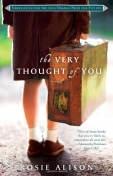BKMT READING GUIDES
The Very Thought of You: A Novel
by Rosie Alison
Paperback : 336 pages
2 clubs reading this now
1 member has read this book
England, 31st August 1939: The world is on the brink of war. As Hitler prepares to invade Poland, thousands of children are evacuated from London to escape the impending Blitz. Torn from her mother, eight-year-old Anna Sands is relocated with other ...
Introduction
Shortlisted for the 2010 Orange Prize
England, 31st August 1939: The world is on the brink of war. As Hitler prepares to invade Poland, thousands of children are evacuated from London to escape the impending Blitz. Torn from her mother, eight-year-old Anna Sands is relocated with other children to a large Yorkshire estate which has been opened up to evacuees by Thomas and Elizabeth Ashton, an enigmatic, childless couple. Soon Anna gets drawn into their unraveling relationship, seeing things that are not meant for her eyes and finding herself part-witness and part-accomplice to a love affair with unforeseen consequences. A story of longing, loss, and complicated loyalties, combining a sweeping narrative with subtle psychological observation, The Very Thought of You is not just a love story but a story about love.
Excerpt
London, 31 August 1939There was a hint of afternoon sunshine as Anna Sands and her mother, Roberta, stepped off their bus into Kensington High Street. To Anna, the broad street flickered with color as shoppers flowed past her, clutching their bags. Beyond the crowds, she could see the parade of shops tricked out with displays of every kind: tins of toffee, new-minted bowls and cups, rolls of ribbons, hats, coats, and gloves from every corner of the empire. ...
Discussion Questions
1. Thomas tells his students, “Things are not always quite as they seem.” The theme of appearance versus reality recurs throughout the book. Discuss some obvious (and not so obvious) examples of this theme. Do the characters use appearances as a shield? As a mask? Is there a difference? What happens to the various characters when appearances are ripped away to reveal the realities beneath?2. There are various examples of marriage, romance and sexual relationships in this novel. Based on your reading, what do you make of the attitudes about marriage during this time? What about attitudes regarding fidelity, sex or love? Do you think the impending war had any role in the way relationships were formed and carried out in this novel?
3. At various points, Thomas, Ruth and Anna all observe that perhaps “just to have loved was enough.” Do you think they truly believe this? Do you believe it?
Notes From the Author to the Bookclub
Note from author Rosie Alison: Ten years ago I was trying to write a contemporary novel set it in London, where I’ve lived all my adult life. But something was holding me back. I kept finding myself diverted back to my childhood, and in particular to a haunting if somewhat run-down stately home on the North York Moors where I spent my formative years, aged 8-12, at a boarding school. But I was very resistant to converting my 1970s school experiences into a novel; that would have felt too direct and personal. Yet all that changed when I was making a documentary about the novelist Elizabeth Bowen, and watched some footage of two nervous evacuees smiling for the camera on a London station platform in 1939. I remember feeling an instant pang about these small children leaving their parents behind – perhaps partly because I had two daughters exactly that age, but also because I remembered the ache of leaving my own home behind at eight. There was an extra resonance for me because I knew that my mother had been evacuated as a wartime child, and that the trauma of that separation from her parents had been a factor, strangely, in sending her own children away from home at a young age. Not long after that, I visited a glorious stately home in Cornwall called Llanhydrock, where they have devoted a special archive to the evacuees who lived there during the war. Again, I found myself gripped by the photographs of these displaced children with their brave smiles. It struck me then that there was a way of writing about the hauntingly beautiful Yorkshire house which had dominated my childhood, but setting it during World War Two. Ashton Park began to form in my mind as a place in which a series of elective affinities play out during wartime, as witnessed by a visiting evacuee. An evacuee is the quintessential displaced or lost child – I think that was why Anna Sands lodged herself in my mind. If ever there were children at crossroads, it was evacuees, who set off on their trains to unknown destinations, and found their lives changed forever by the new families they joined. The emotional consequences still trickle down the years.Book Club Recommendations
Recommended to book clubs by 0 of 0 members.
Now serving over 80,000 book clubs & ready to welcome yours. Join us and get the Top Book Club Picks of 2022 (so far).
Get free weekly updates on top club picks, book giveaways, author events and more








